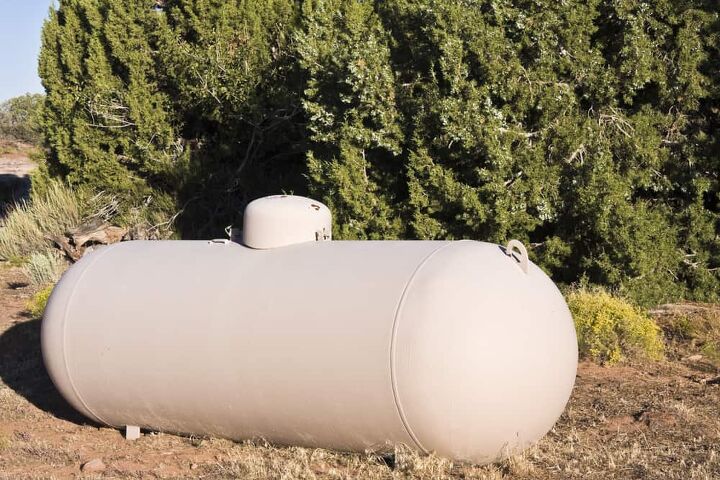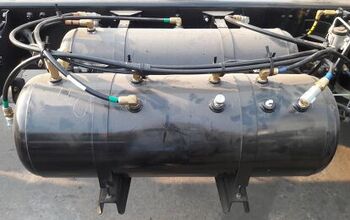How Many Gallons Are In A 100lb Propane Tank?

It is ideal to know exactly what you’re doing when you buy or fill a propane tank. That is especially true for a large, 100-pound propane tank which is quite useful but can be tricky to understand. So, how many gallons are in a 100-pound propane tank?
The average 100-pound propane tank can hold 24 gallons of propane at maximum capacity. Each gallon of propane in a 100-pound tank weighs 4 pounds on average. It is dangerous to put more than 23-25 gallons of useable propane in a 100-pound propane tank because the pressure can fluctuate and cause an explosion.
Larger, 500-propane tanks can hold as much as 125 gallons of propane. Propane is a useful resource, so it is important to know exactly how much suits your tank. Follow along as we explore how many gallons are in a 100-pound propane tank?
Do You Need a Heating and Cooling Contractor?
Get free, zero-commitment quotes from pro contractors near you.

Propane Pounds To Gallons Conversion
According to the EPA, one pound of liquid propane is equivalent to 4.23 gallons. Use the EPA’s conversion tool to figure out how many gallons of propane your tank can hold. The EPA, or Environmental Protection Agency, makes it easy to convert the weight of liquid propane to gallons
| Propane Tank Weight | Gallons of Propane Held |
| 25lbs | 6.25gal |
| 50lbs | 12.5gal |
| 100lbs | 24gal |
| 500lbs | 125gal |
| 750lbs | 187.5gal |
There are just under 24 gallons of propane in a 100-pound tank. Some tanks may be able to fit closer to 25 gallons of propane, but it is best to not push the tank’s capacity. Changes in pressure can cause a propane tank to explode if you overfill it.
How Much Does It Cost to Fill 100-pound Propane Tank?
It costs an average of $96 to fill a 100-pound propane tank. Propane prices vary, but consumers spend an average of $4 per gallon for propane. The average 100-pound propane tank contains 24 gallons of propane, and it’s rare to fill it for less than $78.
However, some cities and counties won’t allow you to fill your propane tank past 85% capacity. In that case, you may only spend $81 at $4 per gallon or $66 at $3.25 per gallon to fill a 100-lb propane tank 85% full. You can keep track of the typical price in your state through The US Energy Information Administration.
What Is The Cheapest Month To Buy Propane?
September and October are the best months to buy propane at a cheap price. Propane prices are cheaper during early fall because there is less demand as the weather cools down in many U.S. regions. Prices increase again during November when it becomes much colder and stays high through February.
Companies like Keystone Propane make it clear that supply and demand is the ultimate decider of propane prices. You’ll often spend closer to $4 per gallon during the summer when more people buy it, and it may cost $3-$3.25 per gallon in early fall when propane isn’t in demand.
How Long Does A 100 lb. Propane Tank Last?
A 100 lb propane tank has about 2.16 BTUs (British Thermal Unit). Because of that, a 100 lb propane tank can last months, depending on how you use it. For example, a 1500 watt electric heater takes 5000 BTUs per hour. You do this by taking the standard unit conversation number (3.41) and multiplying it times the number of watts.
Next, please take the 5000 and put it into 2.16 million, and you get 432 hours, which you divide by 24 to get 18 days of continuous heating. As a result, you can see why it is more appropriate to have a 500 or 1000 gallon tank for your home.
Safety
Do not place them within 3 feet of any building openings such as doors or windows. Double the distance to 6 feet if you are within range of any flammable objects when you store or work with propane. Always make sure that there is a clear path to a fire exit when you have a 100-pound propane tank on your property.
Can a 100-Pound Propane Tank Be Transported On Its Side?
It is not safe to transport a 100-pound propane tank on its side because it can shift and cause damage during travel. Common problems include pressure relief valve damage which can cause your propane tank to potentially leak and work improperly.
Instead, you should load a 100-pound propane tank into a truck and fasten it in place while it stands upright. Use rope, twice, cables, or ratchet straps to secure your propane tank so that it doesn’t move during travel. A 100-pound propane tank that is filled with gas can weigh an extra 90-100 pounds or more, so it is important to fasten it as securely as possible.
Common Propane Tank Sizes
For home use, propane tanks range in size from portable 20-pound containers to tanks that can house more than 2,000 gallons. The size of propane tank that you need will depend on the size of your home and the number and size of appliances that are fueled by the propane.
Though, your local climate and geographical location can also determine your propane tank size. For instance, you may not need as big of a tank for heating in a milder climate than you would in a cold climate.
The following are the most common propane tank sizes, along with their dimensions, capacity, uses, and placement. Though, keep in mind that propane tanks are only filled to 80% capacity in order to allow safe expansion of the propane. So, even when your propane tank is full, the gauge will only display 80%.
20 lb. Propane Tank
Often referred to as grill cylinders, 20-pound propane tanks are portable and hold 4.6 gallons of propane when they’re full.
- Dimensions: 18-inches tall and 12-inches in diameter
- Uses: Patio heaters, generators, propane grills, and other outdoor equipment.
- Placement: Above ground
100 lb. Propane Tank
Again, a 100-pound propane tank holds approximately 25 gallons when full. They are generally portable but may require two people or a dolly to move.
- Dimensions: 4-feet tall and 18-inches in diameter
- Uses: Cooking, dryers, fireplaces, barbecues, temporary heating on job sites, mixed heating systems, and residences with limited propane usage.
- Placement: Above ground
420 lb. Propane Tank
Also commonly known as a 120 gallon propane tank, 420-pound tanks hold about 96 gallons when full. They are not portable and can only be refilled using an on-site propane delivery service.
- Dimensions: 4-feet tall and 3-feet in diameter
- Uses: 1 to 2 residential appliances. Most commonly used for a hot water heater or space heater alone, or alongside another small appliance like a cooktop or dryer.
- Placement: Above ground
250 Gallon Propane Tank
A 250-pound propane tank holds 200 gallons when full.
- Dimensions: 7’10” long and 30″ in diameter
- Uses: Supplemental heating purposes or powering two home appliances, such as a generator, water heater, or pool heater.
- Placement: Above ground
500 Gallon Propane Tank
Many homes that are more than 1,500 square feet choose to upgrade to a 500-gallon tank. Since it holds more, homeowners enjoy the benefit of not having to refill as often. This tank holds around 400 gallons when full.
- Dimensions: 5-feet tall and 10-feet long
- Uses: Fueling propane furnaces, gas ranges, gas water heaters, gas fireplaces, and gas dryers. Commonly used to fuel two or more appliances
- Placement: Above ground or buried underground
1000 Gallon Propane Tank
A 1000-gallon propane tank is most suitable for homes that are 4,500 square feet and larger. This tank holds around 800 gallons when full.
- Dimensions: 5-feet tall and 16-feet long
- Uses: Can be used in homes for whole-home systems, pool heating, or generators. Or, these tanks can be used commercially for cooking, dry cleaning, crop drying, or heating.
- Placement: Above ground or buried underground
Do You Need a Heating and Cooling Contractor?
Get free, zero-commitment quotes from pro contractors near you.

Summing It Up
A 100-pound propane tank holds an average of 24 pounds of propane. Homeowners spend an average of $96 to fill a 100-pound propane tank. Check to see if your municipality has strict rules about propane tank capacity, as some counties only allow you to fill it 85%.

I'm a guy who becomes the expert of whatever I stumble upon, writing-wise. I've written tons about cool home products, home improvement, and smart technology in the home. I'm also the proud father of a kiddo born on new years, making my holidays very busy.
More by Eli Smith














![The 10 Best Table Saws - [2022 Reviews & Buyer's Guide]](https://cdn-fastly.upgradedhome.com/media/2023/07/31/9070645/the-10-best-table-saws-2022-reviews-buyer-s-guide.jpg?size=350x220)












